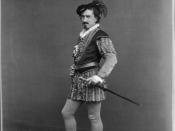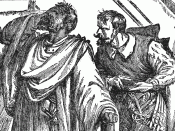Othello is an extraordinary later work of Shakespeare's which, as an indication of true greatness and a testament to its literary worth, can be interpreted in many ways. Two such ways helping us to draw a deeper understanding of society and its values are to be found by making a feminist and racial reading.
Studying the women in Othello one is able to gain an insight into their expected position according to the Elizabethan ethos. This is particularly evident when we examine how they are perceived, their role in relation to the male characters, their own actions and reactions, and importantly, their standing at the conclusion of the play.
There are only three women among the multitudes of men and the carnage of war in this play: a lady, a slave, and a prostitute. When not being utterly adored by the men - acclaiming Desdemona as possessing "beauty, wit and fortunes" (Act I, Scene I, 132) and with the strapping Cassio kissing Emilia and making love to "my most fair Bianca" (Act 3, Scene 4, 164) - they are treated with utter disrespect.
They are physically used and verbally abused by the men they love, all at times called a "wench", a "notable strumpet" and a "villainous whore". Both extremes, women as the exalted and the abhorrent, are inaccurate. Shakespeare does not present a balanced view, and in playing up to the mores of the time does his women a disservice.
In fact, such stereotyping brings into question their exact purpose in the play. They seem to hold importance solely through their connection with men. They are used by Shakespeare as a credible way of bringing to ruin the men about them. Desdemona is the device serving to bring about that jealousy which will prove Othello's fatal flaw and...
![From the Library of Congress: TITLE: Thos. W. Keene. Othello CALL NUMBER: POS - TH - 1884 .O7, no. 1 (C size) [P&P] REPRODUCTION NUMBER: LC-USZC6-58 (color film copy transparency) RIGHTS INFORMATION: No known restrictions on publication. MEDIUM: 1 print (](https://s.writework.com/uploads/9/94760/library-congress-title-thos-w-keene-othello-call-number-pos-thumb.jpg)

